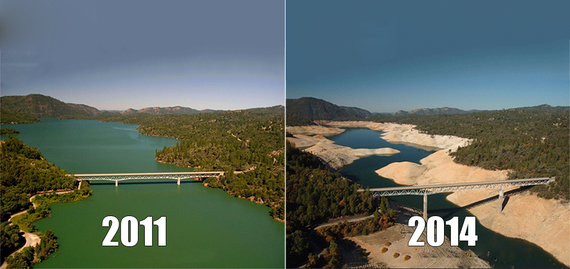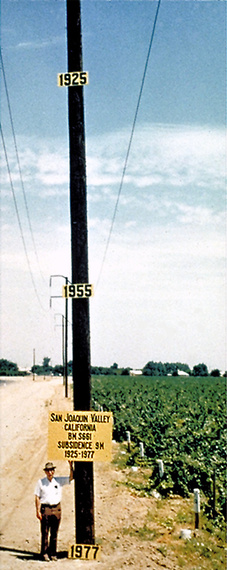Yeah that's right folks, we Californians are not in the midst of a four year drought, but rather suffering from flagrant mismanagement of our most precious life-sustaining and finite resource - water.
That's the word from a man with his finger on the pulse of water supply issues for the past thirty-eight years - Conner Everts.
Everts, is co-facilitator of the Environmental Water Caucus (EWC), a coalition of forty-two environmental groups on a mission to ensure sustainable water management solutions for all Californians. Easier said than done.
Consider recent history - the wet winter of 2010/2011 - when state reservoirs were full.
Everts says if we'd implemented sensible usage and conservation tactics than to deal with California's intermittent supply pattern - years of low rainfall followed by flooding - we wouldn't be so parched now.
Everts blames the so-called drought on our major water agencies planning practices - which are "so last century." Traditionally, these agencies focus on big capital projects - reservoirs and dams - costing billions of taxpayer dollars and often not producing a drop of water for twenty years.
Not something we can afford when NASA Geologist, Jay Famiglietti, says satellite data indicates California has one year of stored water left.
But even though dwindling snowpack can't fill the dams we have -Republicans in Sacramento are sponsoring H.R 2898 - a bill with more tax-payer funded dams, and no immediate water supply solutions.
However it's Governor Brown's mega Sacramento-San Joaquin Delta diversion tunnel with a sixty-eight billion dollar price tag that's the worst. It would complete the controversial 1959 aqueduct project of Governor Pat Brown (Jerry's dad), but violates state and federal environmental laws, will drive native fish species extinct, and do nothing to alleviate immediate water woes.
Everts blasts these white-elephant/legacy projects, especially when cheaper low-tech solutions are staring us in the face.
Anyone with water-reclamation smarts, knows we need to build catchment systems for rainwater. As of now California's rain - when it comes - washes down storm drains straight into the ocean.
And the squandering of potential water sources doesn't stop there - we're also sending almost one million gallons of Southern California's treated wastewater into the oceans every year.
Orange County is recycling 30 percent of its treated wastewater, and the city of Los Angeles recycles 1-2 percent. But direct potable reuse - wastewater being treated so it's clean enough to drink - is not slated to come fully on line for another 20 years in California.
Not good enough for Everts - because not only are we allowing a water resource to slip through our fingers - that water doesn't come cheaply. Wastewater is treated before and after use, so money and energy are expended on both ends of the process.
In fact the 2005 California Energy Commission's Water-Energy Relationship report found water gobbles up nineteen percent of the state's energy. We have the most expensive and elaborate water conveyance systems on the planet - with water transported four hundred miles from northern to southern California, as well as up and over the Tehachapi Mountains.
But what about the real money in the bank - the precipitation that fell thousands of years ago - groundwater? Everts says groundwater is supposed to be like an investment account, the one you don't touch or draw from. But instead Everts states, "we've over-tapped thirteen trillion gallons of groundwater, and there's satellite data showing land subsidence of thirty to fifty feet."
It's the most dramatic land subsidence of anywhere in the United States.
Last year's Sustainable Groundwater Management Act was heralded as a breakthrough - mostly because for the first time there was consensus on protecting this resource. But it will do far too little and way too late, according to Famiglietti. The new law stipulates regional groundwater agencies are formed in the next five years, with sustainability plans due in 2022, and fully operational twenty years after that.
Our groundwater could all be gone by then. Especially with farmers in the San Joaquin valley pumping it like there's no tomorrow.
Agriculture already uses eighty percent of the state's water - four times that of urban use. Everts states our current "arcane pre-1914" water rights laws allow farmers to pump unregulated amounts of groundwater - to irrigate thirsty almond trees planted in the driest parts of the San Joaquin Valley, or forage crops such as alfalfa.
Groundwater is also being depleted to water golf courses. Of the state's eight-hundred-and-sixty-six golf courses, only two-hundred-and-sixteen use any recycled water for irrigation, and one-hundred-and-seventy-seven of our courses are located in the arid Coachella Valley. The California Golf Course Association keeps insisting it deserves a water variance because of the jobs provided.
"It's a case of business-as-usual and putting profit ahead of reality, but if we really are in a drought, doesn't that nonsense have to stop?" asks Everts.
Agencies such as the State Water Resource Control Board are getting hip to conservation, following the lead of southern Californians who've gotten their average daily usage down to one-hundred-and-nineteen gallons. (North Americans are renowned as profligate water users - averaging two-hundred-and-fifty plus gallons a day.)
But whether we reclaim, recycle or conserve - we have to do it quickly. Climate change is barreling towards us, already causing volatile, unpredictable weather. The state's population is estimated to reach sixty million by 2050 - these two factors alone will drastically exacerbate our water needs.
Drought or no drought, California can't be sitting around waiting for a rainy El Nino day - like other communities around the world we have to treat water as though every drops counts.
As Everts sums it up - this means capturing the water we've just used and treating it for its next use - PERIOD.


